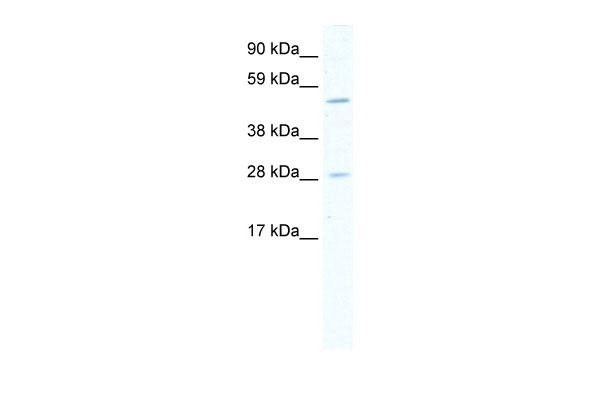ASCL2 antibody - middle region
Rabbit Polyclonal Antibody
- 产品详情
- 实验流程
Application
| WB |
|---|---|
| Primary Accession | O35885 |
| Other Accession | NM_008554, NP_032580 |
| Reactivity | Human, Mouse, Rat, Rabbit, Zebrafish, Dog, Bovine |
| Predicted | Mouse, Rat, Pig, Chicken, Bovine |
| Host | Rabbit |
| Clonality | Polyclonal |
| Calculated MW | 27784 Da |
| Gene ID | 17173 |
|---|---|
| Alias Symbol | Mash2, bHLHa45, 2410083I15Rik |
| Other Names | Achaete-scute homolog 2, ASH-2, mASH-2, mASH2, Ascl2, Mash2 |
| Format | Liquid. Purified antibody supplied in 1x PBS buffer with 0.09% (w/v) sodium azide and 2% sucrose. |
| Reconstitution & Storage | Add 100 ul of distilled water. Final anti-ASCL2 antibody concentration is 1 mg/ml in PBS buffer with 2% sucrose. For longer periods of storage, store at 20°C. Avoid repeat freeze-thaw cycles. |
| Precautions | ASCL2 antibody - middle region is for research use only and not for use in diagnostic or therapeutic procedures. |
| Name | Ascl2 |
|---|---|
| Synonyms | Mash2 |
| Function | Transcription factor (PubMed:10611232, PubMed:29500235). Binds to E-box motifs 5'-CANNTG-3' in the regulatory elements of target genes, probably as a heterodimer with another basic helix-loop-helix (bHLH) protein such as the transcription factor TCF3 (PubMed:10611232, PubMed:29500235). May bind both open and closed chromatin, acting as a pioneer transcription factor to allow other factors to bind and activate lineage-specific genes (PubMed:29500235). Required during post-implantation development for the generation of some differentiated trophoblast cell types (PubMed:8090202). Transcriptional activity of ASCL2 may be antagonised in a subset of trophoblast cells by bHLH transcription factor HAND1, perhaps by competing for dimerization with other bHLH proteins (PubMed:10611232). Involved in differentiation and function of follicular T-helper (Tfh) cells, thereby playing a role in germinal center responses; probably modulates expression of genes involved in Tfh cell function, such as BCL6 (PubMed:24463518). May also act as a suppressor of Th1-, Th2- and Th17-cell differentiation (PubMed:24463518). Induces the formation of stem cells in intestinal crypts in vitro, synergistically activating transcription of target genes, such as SOX9, together with TCF4/beta-catenin (PubMed:25620640). May form a bistable transcriptional switch, controlling expression of its own gene together with Wnt/R-spondin signaling, and thereby maintaining stem cell characteristics (PubMed:25620640). Modulates expression of target genes, including perhaps down-regulating EGR1/Krox24 and chemokine CXCL10/Mob-1 and up-regulating CXCR4 and CDKN1C/p57kip2, in Schwann cells (By similarity). May play a role in reducing proliferation of Schwann cells, perhaps acting via modulation of expression of CDKN1C (By similarity). May be dispensable for blastocyst formation and later embryonic function (PubMed:8090202, PubMed:9622625). May be involved in the determination of neuronal precursors (By similarity). |
| Cellular Location | Nucleus {ECO:0000250|UniProtKB:P19360}. |
| Tissue Location | Expressed in follicular T-helper (Tfh) cells. |
Research Areas
For Research Use Only. Not For Use In Diagnostic Procedures.
Application Protocols
Provided below are standard protocols that you may find useful for product applications.
REFERENCES
Georgiades,P. (2006) Development 133 (6), 1059-1068Reconstitution and Storage:For short term use, store at 2-8C up to 1 week. For long term storage, store at -20C in small aliquots to prevent freeze-thaw cycles.
终于等到您。ABCEPTA(百远生物)抗体产品。
点击下方“我要评价 ”按钮提交您的反馈信息,您的反馈和评价是我们最宝贵的财富之一,
我们将在1-3个工作日内处理您的反馈信息。
如有疑问,联系:0512-88856768 tech-china@abcepta.com.























 癌症的基本特征包括细胞增殖、血管生成、迁移、凋亡逃避机制和细胞永生等。找到癌症发生过程中这些通路的关键标记物和对应的抗体用于检测至关重要。
癌症的基本特征包括细胞增殖、血管生成、迁移、凋亡逃避机制和细胞永生等。找到癌症发生过程中这些通路的关键标记物和对应的抗体用于检测至关重要。 为您推荐一个泛素化位点预测神器——泛素化分析工具,可以为您的蛋白的泛素化位点作出预测和评分。
为您推荐一个泛素化位点预测神器——泛素化分析工具,可以为您的蛋白的泛素化位点作出预测和评分。 细胞自噬受体图形绘图工具为你的蛋白的细胞受体结合位点作出预测和评分,识别结合到自噬通路中的蛋白是非常重要的,便于让我们理解自噬在正常生理、病理过程中的作用,如发育、细胞分化、神经退化性疾病、压力条件下、感染和癌症。
细胞自噬受体图形绘图工具为你的蛋白的细胞受体结合位点作出预测和评分,识别结合到自噬通路中的蛋白是非常重要的,便于让我们理解自噬在正常生理、病理过程中的作用,如发育、细胞分化、神经退化性疾病、压力条件下、感染和癌症。






